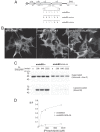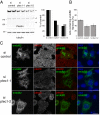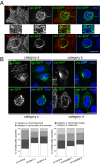The Bin/amphiphysin/Rvs (BAR) domain protein endophilin B2 interacts with plectin and controls perinuclear cytoskeletal architecture
- PMID: 23921385
- PMCID: PMC3779758
- DOI: 10.1074/jbc.M113.485482
The Bin/amphiphysin/Rvs (BAR) domain protein endophilin B2 interacts with plectin and controls perinuclear cytoskeletal architecture
Abstract
Proteins of the Bin/amphiphysin/Rvs (BAR) domain superfamily are essential in controlling the shape and dynamics of intracellular membranes. Here, we present evidence for the unconventional function of a member of the endophilin family of BAR and Src homology 3 domain-containing proteins, namely endophilin B2, in the perinuclear organization of intermediate filaments. Using mass spectrometry analysis based on capturing endophilin B2 partners in in situ pre-established complexes in cells, we unravel the interaction of endophilin B2 with plectin 1, a variant of the cytoskeleton linker protein plectin as well as with vimentin. Endophilin B2 directly binds the N-terminal region of plectin 1 via Src homology 3-mediated interaction and vimentin indirectly via plectin-mediated interaction. The relevance of these interactions is strengthened by the selective and drastic reorganization of vimentin around nuclei upon overexpression of endophilin B2 and by the extensive colocalization of both proteins in a meshwork of perinuclear filamentous structures. By generating mutants of the endophilin B2 BAR domain, we show that this phenotype requires the BAR-mediated membrane binding activity of endophilin B2. Plectin 1 or endophilin B2 knockdown using RNA interference disturbed the perinuclear organization of vimentin. Altogether, these data suggest that the endophilin B2-plectin 1 complex functions as a membrane-anchoring device organizing and stabilizing the perinuclear network of vimentin filaments. Finally, we present evidence for the involvement of endophilin B2 and plectin 1 in nuclear positioning in individual cells. This points to the potential importance of the endophilin B2-plectin complex in the biological functions depending on nuclear migration and positioning.
Keywords: BAR Domain; Cell Biology; Cytoskeleton; Endophilin; Intermediate Filaments; Membrane; Plectin; Protein Assembly; SH3 Domains.
Figures











Similar articles
-
Endophilin B2 facilitates endosome maturation in response to growth factor stimulation, autophagy induction, and influenza A virus infection.J Biol Chem. 2017 Jun 16;292(24):10097-10111. doi: 10.1074/jbc.M117.792747. Epub 2017 Apr 28. J Biol Chem. 2017. PMID: 28455444 Free PMC article.
-
Single point mutation in Bin/Amphiphysin/Rvs (BAR) sequence of endophilin impairs dimerization, membrane shaping, and Src homology 3 domain-mediated partnership.J Biol Chem. 2012 Feb 3;287(6):4232-47. doi: 10.1074/jbc.M111.325837. Epub 2011 Dec 13. J Biol Chem. 2012. PMID: 22167186 Free PMC article.
-
The SH3 binding site in front of the WH1 domain contributes to the membrane binding of the BAR domain protein endophilin A2.J Biochem. 2023 Dec 20;175(1):57-67. doi: 10.1093/jb/mvad065. J Biochem. 2023. PMID: 37812440
-
Endophilin-1: a multifunctional protein.Int J Biochem Cell Biol. 2002 Oct;34(10):1173-7. doi: 10.1016/s1357-2725(02)00063-8. Int J Biochem Cell Biol. 2002. PMID: 12127567 Review.
-
F-BAR family proteins, emerging regulators for cell membrane dynamic changes-from structure to human diseases.J Hematol Oncol. 2015 May 9;8:47. doi: 10.1186/s13045-015-0144-2. J Hematol Oncol. 2015. PMID: 25956236 Free PMC article. Review.
Cited by
-
Endophilin B2 facilitates endosome maturation in response to growth factor stimulation, autophagy induction, and influenza A virus infection.J Biol Chem. 2017 Jun 16;292(24):10097-10111. doi: 10.1074/jbc.M117.792747. Epub 2017 Apr 28. J Biol Chem. 2017. PMID: 28455444 Free PMC article.
-
Mechanics of cell sheets: plectin as an integrator of cytoskeletal networks.Open Biol. 2025 Jan;15(1):240208. doi: 10.1098/rsob.240208. Epub 2025 Jan 29. Open Biol. 2025. PMID: 39875099 Free PMC article. Review.
-
Membrane partitioning and lipid selectivity of the N-terminal amphipathic H0 helices of endophilin isoforms.Biochim Biophys Acta Biomembr. 2021 Oct 1;1863(10):183660. doi: 10.1016/j.bbamem.2021.183660. Epub 2021 Jun 4. Biochim Biophys Acta Biomembr. 2021. PMID: 34090873 Free PMC article.
-
Identifying Plectin Isoform Functions through Animal Models.Cells. 2021 Sep 17;10(9):2453. doi: 10.3390/cells10092453. Cells. 2021. PMID: 34572100 Free PMC article. Review.
-
SH3GLB2/endophilin B2 regulates lung homeostasis and recovery from severe influenza A virus infection.Sci Rep. 2017 Aug 4;7(1):7262. doi: 10.1038/s41598-017-07724-5. Sci Rep. 2017. PMID: 28779131 Free PMC article.
References
-
- McMahon H. T., Gallop J. L. (2005) Membrane curvature and mechanisms of dynamic cell membrane remodeling. Nature 438, 590–596 - PubMed
-
- Itoh T., De Camilli P. (2006) BAR, F-BAR (EFC) and ENTH/ANTH domains in the regulation of membrane-cytosol interfaces and membrane curvature. Biochim. Biophys. Acta 1761, 897–912 - PubMed
-
- Zimmerberg J., Kozlov M. M. (2006) How proteins produce cellular membrane curvature. Nat. Rev. Mol. Cell Biol. 7, 9–19 - PubMed
-
- Masuda M., Mochizuki N. (2010) Structural characteristics of BAR domain superfamily to sculpt the membrane. Semin. Cell Dev. Biol. 21, 391–398 - PubMed
Publication types
MeSH terms
Substances
LinkOut - more resources
Full Text Sources
Other Literature Sources
Research Materials
Miscellaneous

